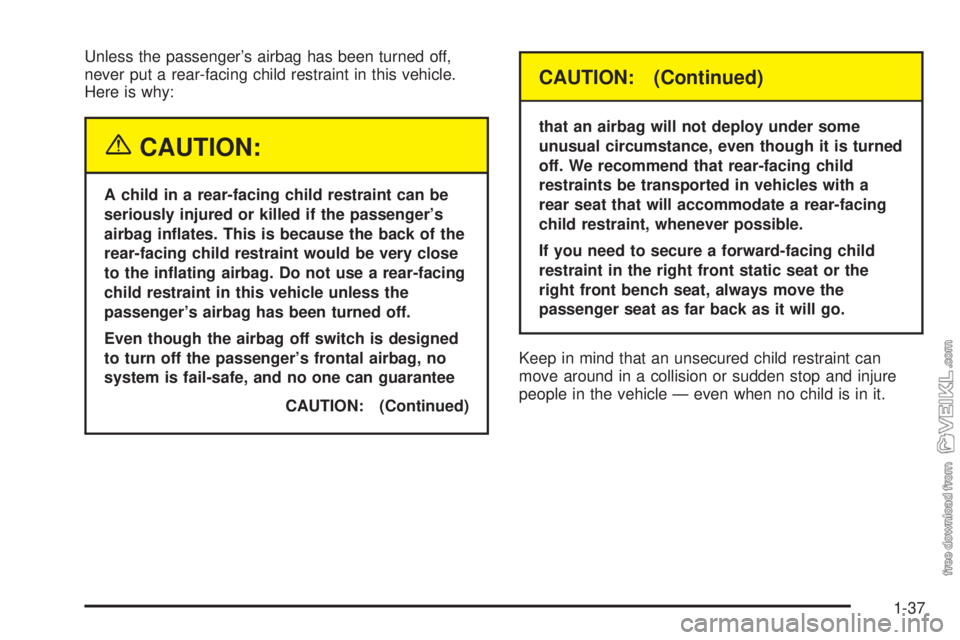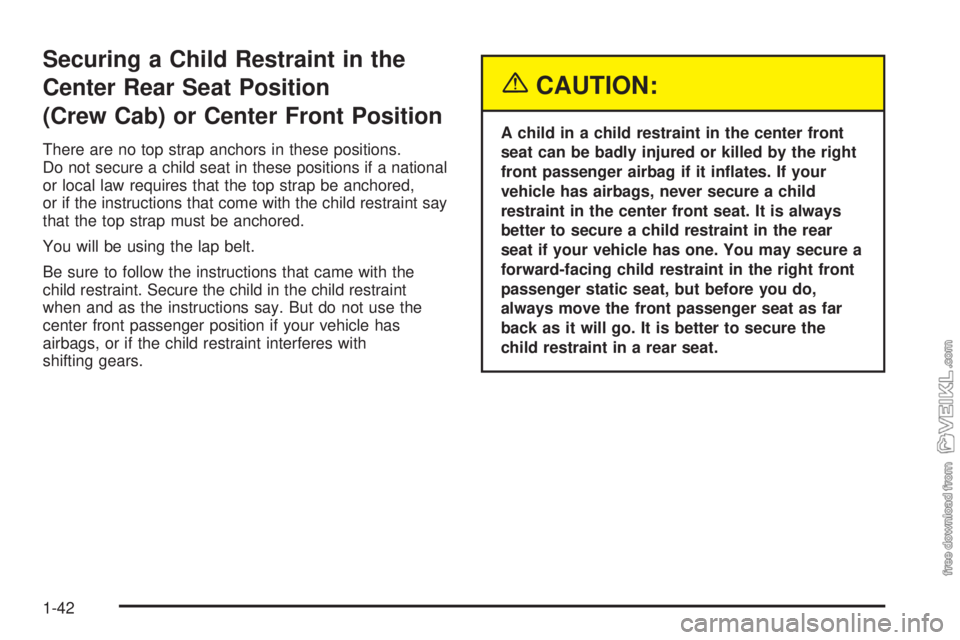Page 43 of 374

Unless the passenger’s airbag has been turned off,
never put a rear-facing child restraint in this vehicle.
Here is why:
{CAUTION:
A child in a rear-facing child restraint can be
seriously injured or killed if the passenger’s
airbag in�ates. This is because the back of the
rear-facing child restraint would be very close
to the in�ating airbag. Do not use a rear-facing
child restraint in this vehicle unless the
passenger’s airbag has been turned off.
Even though the airbag off switch is designed
to turn off the passenger’s frontal airbag, no
system is fail-safe, and no one can guarantee
CAUTION: (Continued)
CAUTION: (Continued)
that an airbag will not deploy under some
unusual circumstance, even though it is turned
off. We recommend that rear-facing child
restraints be transported in vehicles with a
rear seat that will accommodate a rear-facing
child restraint, whenever possible.
If you need to secure a forward-facing child
restraint in the right front static seat or the
right front bench seat, always move the
passenger seat as far back as it will go.
Keep in mind that an unsecured child restraint can
move around in a collision or sudden stop and injure
people in the vehicle — even when no child is in it.
1-37
Page 44 of 374

Where to Put the Restraint
(Crew Cab Models)
Accident statistics show that children are safer if they
are restrained in the rear rather than the front seat.
We recommend that child restraints be secured in a rear
seat position, including an infant riding in a rear-racing
infant seat, a child riding in a forward-facing child
seat and an older child riding in a booster seat.
If your vehicle has airbags and you need to secure a
child restraint in the right front passenger’s seat, there is
a switch on the instrument panel that you can use to
turn off the passenger’s airbag. SeeAirbag Off Switch
on page 1-56andSecuring a Child Restraint in the Right
Front Seat Position on page 1-44for more on this,
including important safety information.Unless the passenger’s airbag has been turned off,
never put a rear-facing child restraint in this vehicle.
Here is why:
{CAUTION:
A child in a rear-facing child restraint can be
seriously injured or killed if the right front
passenger’s airbag in�ates. This is because
the back of the rear-facing child restraint
would be very close to the in�ating airbag.
Be sure to turn off the airbag before using a
rear-facing child restraint in the right front
seat position.
Even though the airbag off switch is designed
to turn off the passenger’s airbag, no system
is fail-safe, and no one can guarantee that an
airbag will not deploy under some unusual
circumstance, even though it is turned off.
We recommend that rear-facing child restraints
be secured in the rear seat, even if the airbag
is off.
CAUTION: (Continued)
1-38
Page 45 of 374

CAUTION: (Continued)
If you need to secure a forward-facing child
restraint in the right front static seat or right
front bench seat, always move the front
passenger seat as far back as it will go.
It is better to secure the child restraint in a
rear seat.
If your vehicle has an air-suspension seat in the right
front passenger’s position, do not secure a child restraint
there. Here is why:
{CAUTION:
A child restraint cannot be secured properly in
an air-suspension type seat. This is because
an air-suspension seat is designed to move up
and down for an adult passenger. Do not use a
child restraint in an air-suspension seat.Wherever you install a child restraint, be sure to secure
the child restraint properly.
Keep in mind that an unsecured child restraint can
move around in a collision or sudden stop and injure
people in the vehicle — even when no child is in it.
Top Strap
Some child restraints have a top strap, or “top tether,”
which can help hold the child restraint during a
crash. For it to work, a top strap must be properly
anchored to the vehicle. Some child restraints with a
top strap are designed to be used whether or not the top
strap is anchored. Others require that the top strap be
anchored. Also, a national or local law may require
that the top strap be anchored.
If your child restraint top strap must be anchored, then
do not use the restraint in this vehicle, because in
it, a top strap cannot be properly anchored.
1-39
Page 46 of 374
Securing a Child Restraint in a
Rear Outside Seat Position
(Crew Cab Models)
There are no top strap anchors in the rear outside seat
positions. Do not secure a child seat in these positions
if a national or local law requires that the top strap
be anchored, or if the instructions that come with the
child restraint say that the top strap must be anchored.
You will be using the lap-shoulder belt. SeeTop
Strap on page 1-39if the child restraint has one.
Be sure to follow the instructions that came with the
child restraint. Secure the child in the child restraint
when and as the instructions say.
1. Put the child restraint on the seat.
2. Pick up the latch plate, and run the lap and shoulder
portions of the vehicle’s safety belt through or
around the restraint. The child restraint instructions
will show you how.3. Buckle the belt. Make sure the release button is
positioned so you would be able to unbuckle the
safety belt quickly if you ever had to.
1-40
Page 47 of 374
4. Pull the rest of the shoulder belt all the way out of
the retractor to set the lock.5. To tighten the belt, push down on the child restraint,
pull the shoulder portion of the belt to tighten the
lap portion of the belt and feed the shoulder
belt back into the retractor. If you are using a
forward-facing child restraint, you may find it helpful
to use your knee to push down on the child
restraint as you tighten the belt.
6. Push and pull the child restraint in different
directions to be sure it is secure.
To remove the child restraint, just unbuckle the vehicle’s
safety belt and let it go back all the way. The safety
belt will move freely again and be ready to work for an
adult or larger child passenger.
1-41
Page 48 of 374

Securing a Child Restraint in the
Center Rear Seat Position
(Crew Cab) or Center Front Position
There are no top strap anchors in these positions.
Do not secure a child seat in these positions if a national
or local law requires that the top strap be anchored,
or if the instructions that come with the child restraint say
that the top strap must be anchored.
You will be using the lap belt.
Be sure to follow the instructions that came with the
child restraint. Secure the child in the child restraint
when and as the instructions say. But do not use the
center front passenger position if your vehicle has
airbags, or if the child restraint interferes with
shifting gears.
{CAUTION:
A child in a child restraint in the center front
seat can be badly injured or killed by the right
front passenger airbag if it in�ates. If your
vehicle has airbags, never secure a child
restraint in the center front seat. It is always
better to secure a child restraint in the rear
seat if your vehicle has one. You may secure a
forward-facing child restraint in the right front
passenger static seat, but before you do,
always move the front passenger seat as far
back as it will go. It is better to secure the
child restraint in a rear seat.
1-42
Page 49 of 374
1. Make the belt as long as possible by tilting the latch
plate and pulling it along the belt.
2. Put the child restraint on the seat.
3. Run the vehicle’s safety belt through or around the
restraint. The child restraint instructions will show
you how.4. Buckle the belt. Make sure the release button is
positioned so you would be able to unbuckle the
safety belt quickly if you ever had to.
5. To tighten the belt, pull its free end while you push
down on the child restraint. If you are using a
forward-facing child restraint, you may find it helpful
to use your knee to push down on the child restraint
as you tighten the belt.
6. Push and pull the child restraint in different
directions to be sure it is secure.
To remove the child restraint, just unbuckle the vehicle’s
safety belt. It will be ready to work for an adult or
large child passenger.
1-43
Page 50 of 374

Securing a Child Restraint in the
Right Front Seat Position
Do not use a child restraint with an air suspension seat.
{CAUTION:
A child restraint cannot be secured properly in
an air-suspension type seat. This is because
an air-suspension seat is designed to move up
and down for an adult passenger. Do not use a
child restraint in an air-suspension seat.
There is no top strap anchor in this position. Do not
secure a child seat in this position if a national or local
law requires that the top strap be anchored, or if the
instructions that come with the child restraint say that the
top strap must be anchored. SeeTop Strap on page 1-39
if your child restraint has one.
If your vehicle has a right front passenger airbag,
there is a switch on the instrument panel that you can
use to turn off the right front passenger’s airbag
when you need to secure a child restraint in the right
front passenger’s position. SeeAirbag Off Switch
on page 1-56for more on this, including important safety
information.A rear seat is a safer place to secure a forward-facing
child restraint. Never put a rear-facing child restraint
in the right front passenger’s seat unless the airbag
is off. Here is why:
{CAUTION:
A child in a rear-facing child restraint can be
seriously injured or killed if the passenger’s
airbag in�ates. This is because the back of the
rear-facing child restraint would be very close
to the in�ating airbag. Do not use a rear-facing
child restraint in this vehicle unless the
passenger’s airbag has been turned off.
Even though the airbag off switch is designed
to turn off the passenger’s frontal airbag, no
system is fail-safe, and no one can guarantee
that an airbag will not deploy under some
unusual circumstance, even though it is
turned off. We recommend that rear-facing
child restraints be transported in vehicles with
a rear seat that will accommodate a rear-facing
child restraint, whenever possible.
CAUTION: (Continued)
1-44